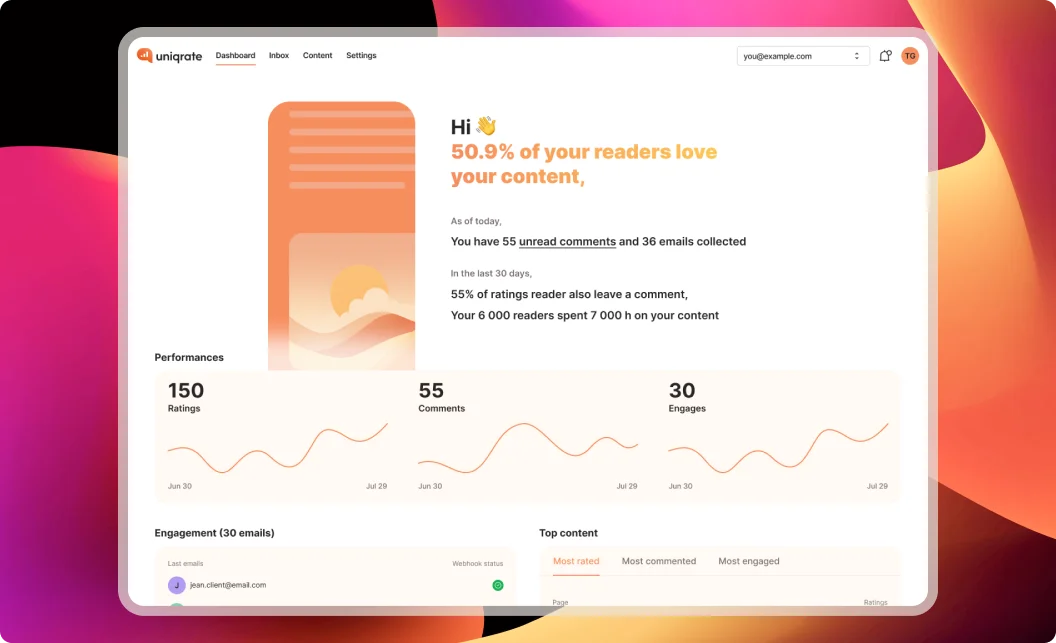Running a blog successfully requires more than just compelling content. To truly grow and engage your audience, you need to understand how readers interact with your posts. Analytics tools are indispensable for gathering insights, but with so many options available, choosing the right one can feel overwhelming. This guide will help you decide which analytics tool is best for your blog.
What to look for in a blog analytics tool
When selecting an analytics tool for your blog, consider these key features:
- Ease of use: The tool should be intuitive and not overly technical.
- Content-specific insights: Look for metrics like engagement rate, reading time, and popular topics.
- Feedback collection: A good tool should go beyond numbers, offering ways to capture reader opinions.
- Privacy compliance: Especially in regions with strict regulations like GDPR, privacy is essential.
Let’s explore some top analytics tools and their features to help you make an informed decision.
Top analytics tools for bloggers
1. Uniqrate
Uniqrate is tailor-made for bloggers and technical writers who want to improve content quality and engagement.
Key features:
- Combines traditional analytics with real-time reader feedback.
- Displays social proof with statements like "100 people loved this content" to boost credibility.
- Privacy-friendly and fully compliant with GDPR, with no cookies or intrusive banners.
- Includes a lightweight feedback island seamlessly integrated into your website.

Why choose Uniqrate?
It’s perfect for bloggers who want actionable insights to refine their content and engage readers effectively.
2. Google Analytics
Google Analytics is a robust, free tool widely used for tracking website performance.
Key features:
- Provides detailed traffic data, including page views, user demographics, and acquisition channels.
- Advanced segmentation for deep insights into audience behavior.
- Integration with other Google tools like Search Console.
While comprehensive, Google Analytics can feel overly complex for bloggers who primarily want to focus on content performance.
3. Plausible Analytics
Plausible is a lightweight, privacy-focused analytics tool ideal for bloggers who prioritize simplicity.
Key features:
- Tracks essential metrics like page views, visit duration, and referral sources.
- Cookie-free and compliant with privacy regulations.
- Simple, clean dashboard for quick access to key insights.
However, Plausible lacks advanced features like reader feedback collection, making it more suited for basic analytics needs.
4. Hotjar
Hotjar provides qualitative data through heatmaps and session recordings, helping you understand user interactions on your blog.
Key features:
- Visualizes where readers click, scroll, and hover on your site.
- Includes feedback polls and surveys for reader opinions.
- Session recordings to see real-time user journeys.
While Hotjar is excellent for understanding user behavior, it doesn’t focus specifically on content performance.
Why Uniqrate is a game-changer for bloggers
Uniqrate is designed specifically for content creators, offering unique features like:
- A feedback-driven dashboard to identify your most loved and most improvable content.
- Smart triggers to encourage reader interaction at key moments.
- Revote mode that allows readers to update their feedback, ensuring it’s honest and accurate.

These features make Uniqrate a comprehensive solution for bloggers who want both quantitative and qualitative insights.
Conclusion
The best analytics tool for your blog depends on your goals and priorities. If you need a basic understanding of traffic and audience demographics, tools like Google Analytics or Plausible are great choices. However, for bloggers focused on improving engagement and content quality, Uniqrate offers unparalleled value.
By combining analytics with feedback, Uniqrate empowers you to create content your readers truly love. Ready to level up your blog? Start using Uniqrate today!

